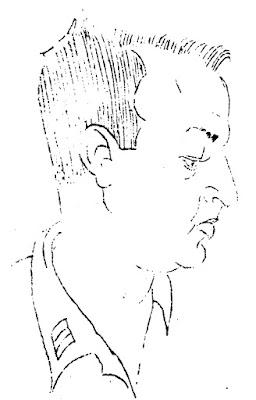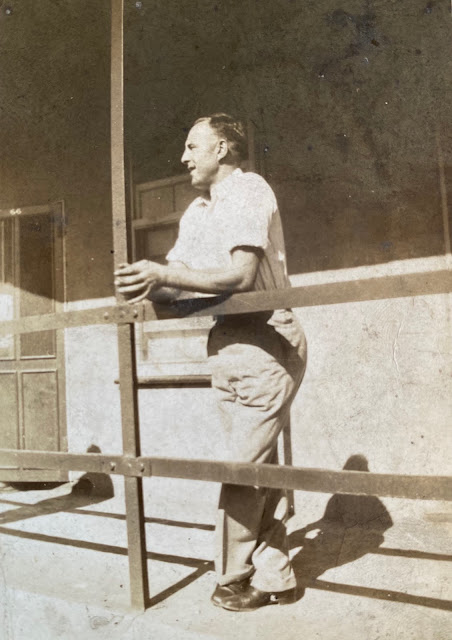Updated 23 January 2023
A Lithuanian refugee himself, Vladas Zibas was the International Refugee Organization's (IRO) Escort Officer for the first group travelling to Australia on the USAT General Stuart Heintzelman. His family name appears to be a contraction of Zibinskas, used by his parents and siblings. Here are his life and views as summarised in the Souvenir Edition, 1st Sailing to Australia.
 |
| Profile sketch of Vladas Zibas from the Souvenir Edition |
Vladas Zibas was born at Palanga, Lithuania, in 1910. He finished a Teachers' Seminary and worked as a teacher for two years, In 1931 he was enrolled in the Lithuanian Army and sent to a Military school. He remained in the Army until 194O. Last rank Captain. In 1944 he was forced to go to Germany and to work there as agricultural worker. After liberation in l945 he has been connected with Displaced Persons' Operations all the time.
When interviewed, the Escort Officer who is the representative of IRO aboard this ship and has to hand over the transport to the Australian Government expresses his full contentment with the voyage. Bound to the same task, he has been on two similar trips before: once to Brazil and the other time to Canada. This is his third passage, the longest and the finest (and his first to Australia) — we have not met rough weather and only comparably few cases of seasickness have occurred. It is the first time that there are no families and children on the transport and the first time when there are (sic) a homogeneous group of people on the trip consisting only of Baltics.
"This makes a great difference in my work", Mr Zibas says. "It is much easier to cope with single persons, I have met very good co-operation and the passengers self-government has helped facilitate my job too." The Escort Officer wishes to offer many thanks to all the fine co-operators who have voluntarily endeavoured to carry out the administrative work and to turn the life on board the ship pleasant. In general I wish my Baltic countrymen all the very best and a good fortune in the new country. Start your new life and be happy.
Since Vladas Zibas, his wife and one son resettled in America in 1950, Ancestry.com provides access to public information about their later life. Again, I have used this information to compile a family tree which interested visitors can view, perhaps after they become Registered Guests of Ancestry first.
As the home port for the Heintzelman was New York City and Vladas appears to have been attached specifically to this ship as part of its crew, Ancestry's collection of digitised Arriving Passenger and Crew Lists for the port of New York shows something of his movements between 1947 and 1950. The first trip to Canada did not involve calling in at New York, but the first trip to Brazil has him departing Rio de Janeiro for New York on 3 September 1947. The Heintzelman reached New York on 15 September. There's no record of whether or not Vladas was allowed shore leave but at least he got to view the skyline of the city where he was to resettle three years later.
Four months later, he was in New York again on the Heintzelman after a voyage to Halifax, Canada. A third visit occurred in July 1948, after the Heintzelman took refugees to Peru and Chile. This time, the passage through the Panama Canal on the return trip to New York was recorded also. November 1948 saw his fourth visit to New York after a voyage from Bremerhaven to Buenos Aires, Argentina.
In January 1949, Zibas visited New York for the last time as an Escort Officer, on a voyage which had originated in Port-of-Spain, Trinidad. Who knew that Europe's Displaced Persons were resettled on Caribbean islands as well as in Australia, New Zealand, and various countries of North and South America? Or did the ship call at Port-of-Spain to re-provision for the trip to New York?
The Crew List for his 1947 trip to New York from Brazil shows an Assistant Escort Officer named Anna R Van Der Loeff. Her name also appears on a crew list for Heintzelman trip to Australia held by the National Archives of Australia. While the sketch of Vladas reproduced above shows a smile, I have heard nothing good nor bad from his passengers about the Escort Officer. The women passengers, in contrast, hated Van Der Loeff for her daily inspections of their cabins and her behaviour if there was anything out of place, such as spilled face powder which had not been cleaned up. At 5 feet 10 inches, she probably towered over most of the female passengers too. Hate is not too strong a word for the descriptions I heard about her 50 and 60 years later!
There might have been feedback to Zibas and his employers because, on what was probably the very next voyage of the Heintzelman, to Halifax and New York in January 1948, her name had been crossed off the crew list. It was overwriten by the name of an English woman. The IRO may have had a preference for providing employment to the refugees because subsequent crew lists show the Assistant as an Estonian man, Herman Malvet.
Sailing the world or, at least to Australia via the Mediterranean, the Suez Canal and Colombo in what is now Sri Lanka, plus Canada, the United States, South America, the Panama Canal and even the Caribbean, must have been a dream job. Dreams disappear as the reality of mornings take their place. In this case, Zibas had left a wife behind in the Wentorf Displaced Persons Camp outside Hamburg in Germany. Kazimira, known as Kaze, was looking after their son, Algirdas, only 10 years old when Vladas started his Escort Officer job but now perhaps more in need of his father's guidance as a 13-year-old.
 |
| The entrance to the Wentorf Camp Photograph supplied to DPCamps.org by Bogdan Karasek of Canada |
There's a gap in Vladas' records between the January 1949 trip from the Caribbean to New York and an August 1950 Wentorf Camp record, available through the Arolsen Archives, showing that the family of three was about to leave for the United States. Their sponsor was the National Catholic Welfare Conference (NCWC on the records).
They were leaving for a known address, 103-41 106th St, Ozone Park in New York City. This may have been an apartment in a building owned by the Catholic Church and used by the NCWC for initial reception. The former Captain of the Heintzelman, Cort M Pedersen, had lived in the suburb of Ozone Park also. Sad to say, he had been dead for more than 20 months by the time his former crew member with family set out on a sister ship to the Heintzelman, the General WG Haan.
By 1951, the family had moved from New York to the neighbouring state of New Jersey. As noted in an earlier entry to this blog, New Jersey was also the home state of the US Army offier who was Commander of the Heintzelman, Captain Valentine Pasvolsky. You might have thought that they got back in touch but contacting people who have been in your life is so much easier in the 2020s than it was 70 years ago. At least a switchboard operator in the 1950s would be willing to find someone's telephone number for you, but homes did not always have their own phones. A search for someone's phone number was likely for business reasons or an emergency only. You could not write a letter to someone unless you already had their address or, at least, a rough idea of it. At the time of the 1950 Federal Census, New Jersey already had a population of 4.8 million, a bit behind Melbourne's current population. Searching out someone for social reasons was like hunting for the proverbial needle hidden in hay.
Instead, we have Vladas Zibas becoming an evening student at Fairleigh Dickinson University. Perhaps he was studying subjects related to his previous employment or subjects making him immediately more employable in New Jersey. No, he was studying astronomy. Maybe evenings on board the Heintzelman had been employed in star-gazing, especially when there were no passengers on board to be administered.
He was a good student too, making the Dean's List every year but one, which mean that he had a B average grade. The year he wasn't on the Dean's List was when he was on the University's Honors List, meaning a B+ or better average.
Meanwhile, the only publicly available information on his employment in the United States lists him as a 'dyewkr' in New Jersey in 1956. There is nothing on the Web to suggest that he actually worked as an astronomer after his graduation. At least his studies meant that his photograph appeared in the Fairleigh Dickinson Yearbook for 1963.
 |
| Vladas Zibas as an astronomy student, Fairleigh Dickinson University, 1963 |
Algirdas had beaten his father to graduation from the same institution, with a Bachelor of Science degree in electrical engineering in 1961. Again, and thanks to Ancestry, this means that a Yearbook photograph is available.
 |
| Algirdas Zibas, BS in Electrical Engineering, Fairleigh Dickinson University, 1961 |






















